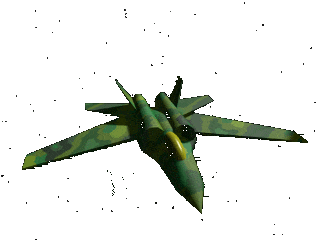
H E L L F I G H T E R

Class: Space Superiority Fighter
Features:
Strengths:
Weaknesses:
Tactics: The Hell Fighter advanced flight systems make it a relatively easy fighter to fly. Tactically, it is a very agressive fighter. It lives for point blank, knife fighting combat. While this unit's weapons may seem most effective in the middle of a swarm of enemy fighters, the pilot is cautioned to not make the transition from aggressive to fool hardy. The Hell Fighter may be heavily gunned, but it is nearly as vulnerable to enemy fire as the more common Shrike. Many an over enthusiastic pilot has met their demise when they forgot this.
Many more have gone down after running out of ammunition. The gatling cannon has a very high rate of fire. It's rockets are a one shot item. And the heat seekers, as always, never last long enough. These fighters can and do 'go winchester' (pilot speak for empty weapons) in a hurry.
The powerful gatling cannon and rocket packs give this fighter the unique ability to literally punch its way through a swarm of enemy fighters, cutting a (relatively) safe corridor through. This tactic is known as pile driving. It's effective, but dangerous. And it will eat ammunition quickly.
Most fighters will not survive a head on shooting match with a Hell Fighter.
History: The Hell Fighter is the brain child of Dr. Sean Crowley. Dr. Crowley envisioned the Hell Fighter long before he ever got a chance to start work on it.
In his early years, he was enlisted as an engineer on the Star Fighter project. He proved his engineering prowess with the innovative design of the Star Fighter's manuevering system, making this fighter far more agile than its opponents... the only advantage it had against the technologically superior Dz'Isu Empire. The Star Fighter stood as Earth's hope during a time when hope was in short supply.
When the first working shield system was captured and reverse engineered, Dr. Crowley was called upon to retrofit the Star Fighter design to mount energy shields. Two days later he reported to the Terran Alliance Commanders in Chief that the Star Fighter simply could not mount such a system.
A new design was needed. Dr. Crowley was directed to design a fighter which would employ the new shielding technology. Seeing his chance to build the fighter he had always dreamed of, he immediately set out designing the Hell Fighter and brought his preliminary design concepts to the high command. But it was not to be. His designs were rejected as far too complex and expensive to be feasable. He was ordered to simplify the design and produce a cheap, cost effective fighter. Grudgingly, he did so, and the project became the SF-16 Shrike.
The Shrike proved to be a very successful fighter. Yet still Dr. Crowley argued that his original designs would make a far better fighter. Eventually, he managed to cash in a favor owed him by a couple of members of the high command and gained clearance to begin the Hell Fighter project. The project held great opposition by the rest of the high command and held a very precarious position during the two years of Hell Fighter development before the first prototype was ready.
The first field tests of the prototype were to be conducted against the old Star Fighters, but Dr. Crowley insisted on using Shrikes as the test opposition. The prototype Hell Fighter was placed up against, also at Dr. Crowley's insistance, not one, but three SF-16B Shrikes. 'By God, I'll show them,' he said, 'Too complicated and infeasible. Feh! I'll show them too complicated and infeasible!' And show them he did. The prototype Hell Fighter ripped the Shrikes to pieces. Astonished, the high command immediately ordered production of the new fighter.
Game Status: Complete.
Game Concept Credit: David Peterson.
Model Concept and Design Credit: Roy Belanger III.
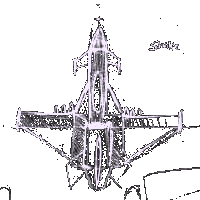
Class: Space Superiority Fighter
Features:
Strengths:
Weaknesses:
Tactics: [Fighter not yet game tested]
History: See Hell Fighter history.
Game Status: Incomplete in game. Model in design sketches.
Game Concept Credit: David Peterson.
Model Concept and Design Credit: Brian Harp.

Class: Space Superiority Fighter
Features:
Strengths:
Weaknesses:
Tactics: Hunters perform strongly by attacking in oblique battlepasses. The intention is to stay out of a direct head on with enemy fighters and left the turret turn to strafe the enemy as you rush by. Be sure to plink them with the rear autocannon as soon as it comes into arc at the tail of your battle pass. Attempt to engage in a turning match with your opponent. The Hunter will almost always win a turning match, not because it can turn faster (because it can't), but because it can often keep its opponent in the edges of its firing arcs for its chain gun and blow its opponent away while the opponent tries to bring its own weapons to bare. The Chain Gun turns slowly, so try to hold your manuevering to let it get a good track. Jinking throws its aim. Parking the Hunter to give it a static track and just letting loose with its cannons will do a great deal of damage, but its a dangerous manuever that often leaves the Hunter a sitting duck. Do not go head to head with Hell Fighters. The Chain Gun may seem like its as powerful (and it does indeed possess a similar rate of fire), but the Gatling Cannon will turn you into swiss cheese first. Hunter pilots usually only find this out once.
History: The Hunter was conceived as a pilotless fighter. It chief designer, Peter O'Brien, was convinced that live fighter pilots were inferior to fast thinking, 'perfect' machines. Computers could react faster, more precisely, and would never falter like human pilots. They would never panic or become confused or lose grasp of their situation. O'Brien spent months perfecting his AI. Gifting it the ability to learn and filling it with strategies. The fighter itself was lightly armored, fast and agile. It was equiped with a rapid fire chain gun mounted on forward facing turret with a 45 degree arc of fire. An autocannon with a 180 degree arc of fire was mounted in a rear facing for anti-missle work (guided missles being the only weapons that O'Brien considered to be a real threat as they are also controlled controlled by computers). The fighter also carried a moderate compliment of missles. In simulation after simulation, the Hunter stalked and destroyed its virtual prey. O'Brien programmed its targets to respond like real pilots... to panic, falter, and use poor judgement. When the prototype Hunter craft was complete, O'Brien was quite pleased to begin field testing. His project held many adversaries who argued that computers would never best flesh and blood pilots. Oh, but he would show them. And the first field tests bore out his theory as the Hunter tore through its adversaries, suprised at the agility and accuracy of this pilotless fighter. The results were not nearly as impressive as O'Brien's simulations had predicted, as the human pilots did not panic nor use as poor judgement as he assumed they would. Nevertheless, the results were remarkable, and full production of the new fighter was immediately ordered. Production of nearly all other fighters was halted and factories were retooled to build the new Hunter design. The Hunters wreaked havoc on their foes and for a time, ruled the battle zone. But this success was to be very short lived. O'Brien checked the reports and statistics of his fighters' effectiveness constantly... and to his dismay, the effectiveness was falling off rapidly day by day. Slowly he came to understand what was happening. The flesh and blood pilots learned. They learned far faster than his AI systems could keep up with. And their tactics were further reaching. An ace pilotting a Shrike illustrated how she could easily destroy an entire squadron of Hunters singlehanded by duping them again and again. The pilotless Hunter's day was over. O'Brien had been wrong. His 'perfect' machines had failed. Thirteen days after the first Hunter destroyed a target on a real live battlefield, Peter O'Brien committed suicide.
The Hunters, however, were already in widescale production in place of most other fighters. They had to be made useful. The AI systems were removed from the Hunters, and they were fitted with cockpits for real pilots. Live pilots could not tolerate the G forces that Hunters could pull, nor could they dodge incoming fire like the AI systems could. Adding a reasonable level of armor slowed the Hunter considerably (almost too much), as its small engines were designed to push a lightly armored fighter. But, the new retrofit was effective. The new fighter still employed an effective turretted weapon system. Much of it was still automatic, but now under the control of real live pilots. The new SF-69B Hunter proved to be an effective fighter and remains in wholly deserved wide scale production today.
Game Status: Complete in game but new and not very tested. Model in design sketches.
Game Concept Credit: David Peterson.
Model Concept and Design Credit: Brian Harp.
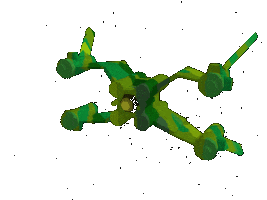
The Wyvern is a pure seat of the pants fighter. Unlike other fighters, the Wyvern isn't filled to the bulkheads with automated systems and sensors. This is a manual craft. Removing these fragile systems left room for a lot more armor and engines. This fighter is a brute... and an agile brute at that. It can outrun, out manuever, out last, and (potentially) outgun a Hell Fighter. Which of these two fighters is the stronger is a very heated argument among their pilots. And results on the battlefield have tended to favor the Hell Fighter. But everyone knows... an ace in a Wyvern is a terribly thing, for surely your death will ensue.
Class: Space Superiority Fighter
Features:
Note: Omni directional thrusters are activated by holding down button 1. With these thrusters activated, the fighter will not turn. Left and right will cause the fighter to slide left and right rather than turning. Note also that fighters with Omni directional thrusters have no brakes. They have reverse thrust instead.
Strengths:
Weaknesses:
Tactics: The Wyvern isn't a fighter for the beginning pilot. You'll find no cushy advanced missle systems or automatic weapon systems here. This is as manual as it gets. The omni directonal thrust combined with heavy engines on this craft make it terribly agile... and also terribly difficult to fly. Putting blasts on target is even more difficult. But in the hands of a skilled pilot, this fighter is devastating. Compared to a Hell Fighter, it is faster, more agile, tougher, better shielded, and (depending on who you ask) just as well armed. Still, only fools believe a Wyvern will survive a headon firing match with a Hell Fighter, but the Wyvern is just as or more heavily armed than the Hell Fighter _if_ it can place its blast cannons on target consistantly and stay out of the way... not an easy task. Wyverns are the masters of in and out fighting tactics. Their omni directional thrusts should be used to weave in and out and all about their opponents, carefully putting blasts on target from angles that deny return fire. Remember, that Hell Fighter can dish out more damage faster than you can. But you can do more damage in single shots than it can. Avoid letting anyone get a lock onto you. The Wyvern has no missle defenses. The best it can do is dodge missles. It can do this effectively, but without any way to really shoot them down effectively, they can quickly add up to situation that can no be ducked. Remeber in and out! Keep their locks broken! This is a close in fighter... so GET IN THEIR FACES! And get out before they can return fire!
History: Most modern fighters are filled to the bulkheads with advanced sensor suites and avionics. Not so for the Wyvern. Initially developed as an experiment to determine if cheaper fighters without advanced avionics could survive in the modern arena, the prototype Wyvern proved (barely) that such fighters could compete cost effectively with other fighters. With this initial success, the designers, who had been arguing from the start that the Wyvern needed more expensive contruction to be truly effective in spite of their administration's insistance on the cheapest contruction possible, were finally able to uprate the design and contruction of the Wyvern. The results were spectacular. The advanced sensors and avionics were still left out of the design. Instead, the Wyvern was filled with stronger structural supports, heavier armor, more powerful engines, and a heavier reactor. The new version of the Wyvern proved to be an incredible success both in mission effectiveness and cost effectiveness, much to the chagrin of the administration, most of whom (the ones whic couldn't find scapegoats) quickly lost their jobs. The Wyvern is concrete proof that seat of the pants flying is still viable even today.
Game Status: Complete.
Game Concept and Model Concept Credit: David Peterson.
Model Design Credit:: Roy Belanger III
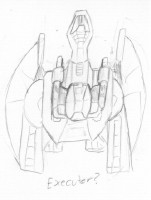
The Executor's main weapons are mounted on a large 360 degree turret. This heavy fighter is fast, but turns like a bathtub.
Class: Space Superiority Fighter
Features:
Strengths:
Weaknesses:
Tactics: Take battle passes. In and out tactics. Use your turret!
History: Incomplete..
Game Status: Incomplete and somewhat broken in game. Model in rough sketches.
Game Concept Credit: David Peterson.
Model Concept and Design Credit: Brian Harp.
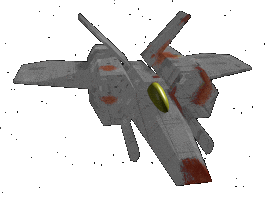
Class: Space Superiority Fighter
Features:
Strengths:
Weaknesses:
Tactics: Stay out of concentrations of fighters and fire. Without shields, stray hits will cripple this fighter. In order to have any chance of success, you must draw your opponent away to fight one on one. You're probably more agile, so use this to your advantage. Close in, these fighters hit suprisingly hard. Remember that. They probably won't be too concerned with a pipsqueak like you, so they'll be be awefully suprised when they feel their bulkheads crack. They just don't build fighters like they used to. History: The Star Fighters were produced in great quantity during last war and many are still found in service on backwater planets today. It was quite a successful fighter design... several years ago... back when shields were unheard of and nobody had SWAT missles or gatlings. Several attempts have been made at retrofitting these fighters with shields, but each has met with failure. The design just isn't able to mount the shield emitters properly. However, the design was found to be a suitable for multiphasic emitters. The M version of this fighter is the most recent retrofit which adds such emitters, allowing the fighter to go out of phase for brief periods.
Game Status: Complete.
Game Concept Credit: David Peterson.
Model Concept and Design Credit: Roy Belanger III.